Our introduction to traditional grains began with
the Save our Rice Campaign that I was involved in. As part of the Campaign,
we were visiting farmers’ farms, meeting and motivating farmers to
conserve traditional paddy varieties, organising seed and rice festivals, and
developing rice diversity blocks. It is as part of the campaign
that I took home the first traditional rice variety, knowing its
name, knowing where it was cultivated it and who farmed it, knowing the
provenance of my food. It was Gandhasaale, an aromatic rice variety, growing in the Western
Ghats, it has a heavenly fragrance that slowly spreads around the
house when the rice starts cooking in the pot. An
interesting story that the farmer told me is that the variety has
fragrance only when it is grown at an altitude and gets low
night temperatures. They discovered it, he said, when a farmer grew it in the
plains and found that the rice had no aroma.
Since the start of the Green Revolution in the 1960s,
its single point agenda of increasing yield of paddy became the
mantra for the agriculture departments/universities in the country. As a
result, traditional varieties have been slowly dying out. When farmers got
seeds from the market, initially really cheap or even free, they stopped saving
seeds. Some committed farmers continued saving and using their traditional
varieties but by the early 2000s most farmers had given up on the traditional
varieties. Over the years, we began losing the thousands
of varieties of land races that were part of our food and agricultural heritage.
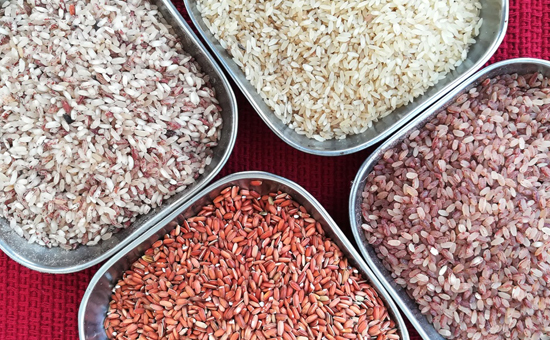 A sample of Rice Diversity. (Credit-Bio Basics)
A sample of Rice Diversity. (Credit-Bio Basics)
At the
same time processed food, with different kinds of food items made with a small
range of grains, have given us the false notion of variety in food. We began
mistaking variety for diversity. Today we have given up diversity and embraced
variety. So we grow and eat less diverse grains, foods and also eat
more non local food, more processed and less whole food, impacting our health
and environmental wellbeing.
The Traditional Rice Varieties
Traditionally,
every variety of rice has had an agricultural and food significance. Some
varieties are suited to certain soils, others require lower night temperatures
or can withstand drought and/or flood, while some others are salinity tolerant. Many
grew tall providing enough hay for fodder and roofing, whereas some had
awn protecting the grain from birds (especially in the aromatic varieties where
the birds are attracted by the aroma that begins right in the field), some were
short season, suitable for the summer rains, whereas others matured slowly
taking all of 180 days. The particularities are endless. Rare scientists
like Dr. R.H. Richharia have documented tens of thousands
of land races and their properties and spent years studying these
varieties.
The
particularities of the varieties do not end with the paddy plants, duration,
seasonality, etc. The grains also have their
unique features. They have specific nutritive,
cooking and eating qualities. Also traditionally specific rice varieties
were used for specific purposes. Every culture had its list of rice for
specific seasons and purposes, which were dependant on the growing season, climate,
cultural observances (which, again, like harvest festivals, were linked to the
agricultural calendar).
The
agricultural families ate the rice they grew. It was converted to parboiled rice in their own yards and either hand pounded or milled and eaten. There were special rices for making tiffin items, those that were preferred for table rice, separate ones for making flattened rice and puffed rice. Aromatic rices had their exalted place, preferred by the royal families. The rices with medicinal properties were another precious bunch. However as one rice expert said, "What medicinal rices? Every traditional variety has some nutritive
or medicinal property. We just need to know it."
Sundararaman Iyer, an organic farming guru from Tamil Nadu says, "The greater the varieties of rice you eat the less you are likely to experience micro-nutrient deficiencies.” Today unfortunately, we have narrowed our choices to a handful of varieties and consume them polished
devoid of fibre and minerals. We, instead, eat a range of processed
foods made with the same grains and mistake variety for diversity. However, it
is diversity that will give us a range of nutritional elements – apart from
fulfilling our need for varied taste. Each of the different rices have their particular
taste profile, and often, most people develop their personal favourites.
In Kerala,
the parboiled red rice was preferred for table rice
with varieties ranging from Thondi
and Paal Thondi from Wayanad, to Kuruva, Chitteni and Chettadi from Thrissur and Palakkad. Each
region had its own specialities. In Palakkad, a variety Thavala Kannan, was cultivated mainly to make aval (flattened rice
or Poha) for offering at the Devi temple.
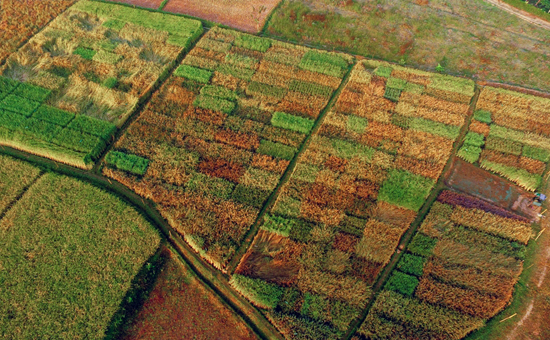 RiceDiversityBlock at Panavelly Agri-ecology Centre,Wananad(Credit-Save our Rice Campaign)
RiceDiversityBlock at Panavelly Agri-ecology Centre,Wananad(Credit-Save our Rice Campaign)
Each
region had hundreds of varieties. The Save Our Rice Campaign alone
conserves over 250 varieties in Wayanad, over 700 varieties (from all over) in
Karnataka, over 140 varieties in Tamil Nadu and hundreds of varieties in
Chhattisgarh/Jharkhand and West Bengal. Of these, most varieties are conserved
as an end in itself, and about twenty to forty varieties are grown in large
quantities to be consumed as rice.
What we have
come to realise is that the enthusiasm that the farmers have to try out and improve
these varieties is unfortunately not matched by willingness of consumers to try
out these diverse varieties. This is due to various reasons. It ranges from
lack of time and attention to focus on cooking in the house to reluctance to
try something new (the irony, however, is that urban consumers are trying newer
cuisines everyday) to something trivial like these varieties take longer
to chew and eat! Most traditional varieties also take
longer to cook, as most are made available with bran. But we overlook the fact that this is what enhances the
nutritional profile of these rices!
For
example, in Tamil Nadu, Mappilai Samba, a traditional rice variety that had almost slipped into oblivion is now
gaining popularity. It is known for its strength giving properties. It got its
name from having been fed to potential bridegrooms so that they could pass the
test of strength to win the bride. Today this rice in its unpolished form is
becoming popular for health reasons and also because it has relatively lower glycaemic
index. Since it takes long to cook, many prefer to use the red rice as flour to prepare popular South Indian snacks
like puttu, kozhukattai and adai with the Mappilai
Samba rice. Similarly the Poha (flattened rice) and puffed rice (pori/kurmura) made with Mappilai Samba are superlative. Not only
can they can be used to make typical South Indian snacks; you can eat it as is or
even make Bhel or Muesli. Such versatility!
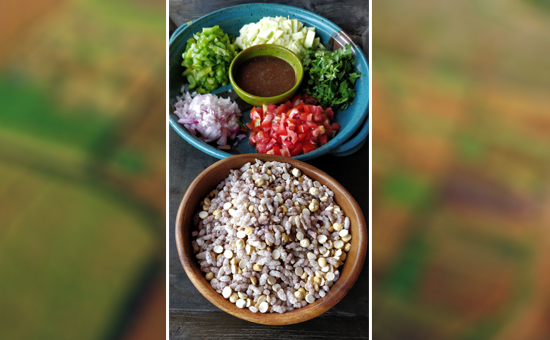 Mappilai Samba Puffed Rice in use for making Bhel (Credit-Bio Basics)
Mappilai Samba Puffed Rice in use for making Bhel (Credit-Bio Basics)
Poongar, another red rice grown in Tamil Nadu is called the women's rice. According to oral knowledge shared by farmers, this rice has
properties to help women overcome many a health problem ranging
from gynaecological issues to joint pains.
Ilupai poo samba, a white rice that is had as
kanji is again preferred by women and used to be regularly consumed by them in
the Thanjavur rice growing belt. With a faint fragrance this rice kanji is
filling and delicious, it gets its name. I distinctly remember during our
travels through Thanjavur visiting rice farmers, unexpectedly I developed a
fever, this was the time we reached the home of Ashokan Anna, who grow Ilupai Poo samba. His wife gave me a cup
of Ilupai poo samba Kanji, I asked for a second cup despite the fever, as it felt
very soothing and light and kept me going.
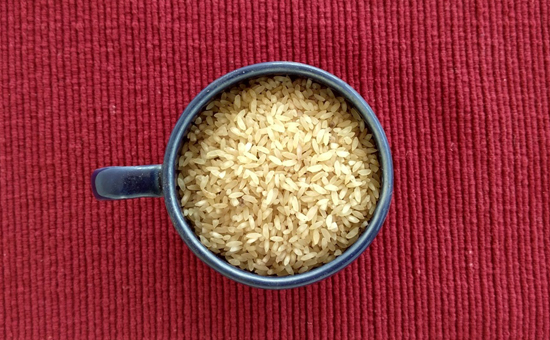 Iluppai Poo Samba Rice (Credit-Bio Basics)
Iluppai Poo Samba Rice (Credit-Bio Basics)
In
Karanataka, Rajamudi rice, one of the varieties preferred by the Wodeyar kings is being revived
by farmers and is gaining popularity. A mix of red and white grain, this is
excellent for table rice and also making variety rice. It is a preferred as it
has the property to mix with the gravies and absorb the taste making it a
delicious table rice suitable for South Indian meals.
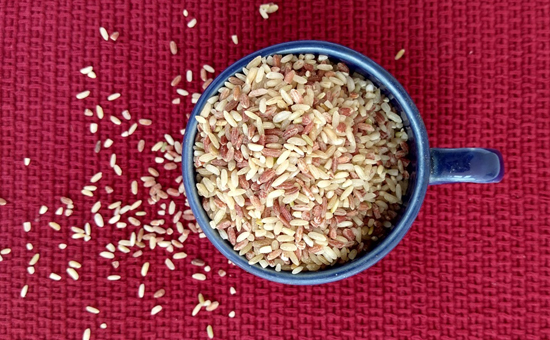 Rajamudi Rice (Credit-Bio Basica)
Rajamudi Rice (Credit-Bio Basica)
We at Bio Basics also offer two traditional white
rice varieties from Tamil Nadu - Kichadi Samba and Thooyamalli. Both have excellent cooking quality and are equally good as parboiled rice or raw rice. I personally
prefer Kichadi Samba because of its
sweetness. These rices are great for making variety rice as well.
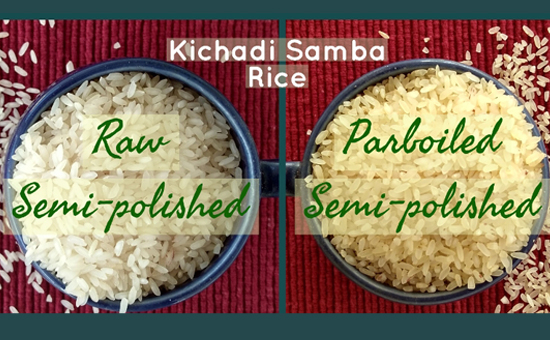 Khichdi Samba Rice (Credit-Bio Basics)
Khichdi Samba Rice (Credit-Bio Basics)
Jeeraga Samba, known as the Basmati of the
South is a
slender, aromatic rice, very popular in Tamil Nadu and Kerala. It is one of our
favourites. One of the peculiarities I have found is that the rice doesn’t go bad, kept outside and is good enough to
be eaten the next day. In fact, this is the case with many
traditional rice varieties. Since the traditional varieties I have consumed are
all grown organically I do not know if this is due to the absence of synthetic
chemicals used in growing or due to the inherent property of the rice
variety.
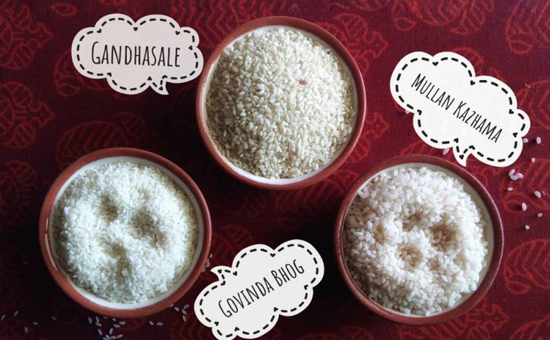 Some Fragrant Rice Varieties (Photo Credit - Bio Basics)
Some Fragrant Rice Varieties (Photo Credit - Bio Basics)
The Gobinda Bhog aromatic rice from West Bengal, small grained, sticky, with an aroma is
delicious to make kheer (payasams) or any sweet. I love this rice for just
plain rice also; it makes any side dish palatable and just goes down the throat
like a fragrant breeze.
How can I
forget the Mullankazhama, the aromatic rice that had almost disappeared from the fields and our
plates, but has fortunately been revived? Neither slender nor small, this round
grained unusual looking aromatic rice has a unique flavour and is preferred for
making the Malabari
Biriyani. Like every other aromatic rice this is also excellent for
making desserts.
The medicinal rices are an altogether different class.
Each has its own property, from dealing with acne to arthritis to pregnancy
related issues to cancer to headaches to skin infections to stomach upset to
heartburn and much more. Navara being the most well-known, used extensively in
Ayurveda for external use as kizhis
and also for consuming as kanji.
This is not the only one; Valiya
Chennelu, Raktasali, Karibhatta and numerous others are a storehouse
of curative properties. And this is not even the tip of the richness that is
available.
How about trying some traditional rice varieties?
The farmers
are doing their bit of growing diverse varieties, under organic conditions and
bringing it to us with minimal processing. Now what do we have to do? I suggest
we stop outsourcing the most important task in our life - how and what to feed
our families and ourselves.
We are
happy to try out new cuisines, variations of existing cuisines. Then why do we
hesitate to try out a new rice? We know our taste buds have a life span of twenty
one days and we can get used to any new food. So, why don’t we try the various rice varieties?
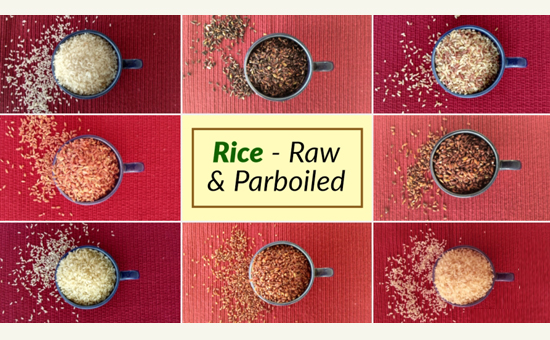 Traditional
Rice Varieties - Raw & Parboiled (Photo Credit - Bio Basics)
Traditional
Rice Varieties - Raw & Parboiled (Photo Credit - Bio Basics)
It is only when we connect to farming, farmers and
food can we understand the inextricable relationship we have with the
traditional rice varieties of our region. Today with modern
transportation, we also have the privilege of trying rice varieties from
different regions. The commitment of the seed saver farmers should be
matched with our passion to incorporate these varieties into our diets.
If we devote some
time to experiment with these varieties, if we can commit some time to prepare
innovative , tasty dishes with unpolished/semi polished rice we would be spared
the difficulty of cutting it out of diets, for fear of diabetes and obesity.
Paddy
rice is not the culprit, we are the culprits,
we polish the rice beyond recognition, we do not try out the range of
traditional rice varieties with diverse nutritive profiles, and we do not try
new and interesting ways of preparing and making them popular. In any case, all
of us from rice growing regions love rice. Like the farmers who have begun
conserving out of sheer love for the grains, let us do our bit to learn more,
prepare more varieties and adopt them into our diets in a healthy and delicious
form.
This is
just the story of rice; we have similar deep
diversity in millets, wheat, pulses, and so on. What we need to do is
eat our way into diversity. Only if we eat
diversity will the farmers grow it. Only if the farmers grow these
diverse varieties of these diverse crops – this agri-biodiversity – can we maintain
and carry forward this heritage of seeds, which is the collective wealth of
humankind.
Author is the
Co-Founder of Bio Basics, a social venture retailing organic food and a
Consultant to the Save Our Rice Campaign.
Also read
1 Why the rise of local grains is
not just about health
“Every
region and tribal belt in India has its own local variety and preparation style
of millets. While jowar and bajra are popular
in the West, grains like oodhalu (barnyard millet) and navane (foxtail
millet) are more popular in the South. In fact, some of these hardy grains have
been mentioned in our ancient texts like the Yajurveda, which talk
about agriculture, economic and social life during the vedic era. Yet, their
consumption and cultivation had been on the decline for the better part of the
last century. In 2016-17, the area under millets stood at 14.72 million hectares,
down from 37 million hectares in 1965-66, before the pre-Green Revolution,
according to a March report by Hindu Business Line.” Article
excerpts published in MINT newspaper.
2 How Andhra
Pradesh is taking to natural farming
3 Native seeds are
a key to food security
4 Sangrur Punjab:
A Harvest of Distress
5 Madhya Pradesh
farms a green revolution
6 Virtues of Drip
Irrigation
7 India’s Constant
Gardeners
8 The rise of MILLET